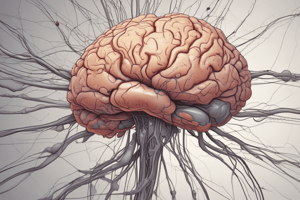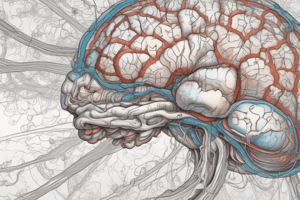Podcast
Questions and Answers
What are the four main parts of a neuron and what is their general function?
What are the four main parts of a neuron and what is their general function?
The four main parts of a neuron are dendrites (receive signals), cell body (integrates information), axon (transmits signals), and terminals (release neurotransmitters).
How do neurons differ in terms of structure and function?
How do neurons differ in terms of structure and function?
Neurons differ in terms of structure (number of dendrites and axons, cell body shape) and function (sensory, motor, interneurons).
What are the functional roles of neurons and glia in the brain?
What are the functional roles of neurons and glia in the brain?
Neurons transmit and process information, while glia provide support and maintenance functions.
What forces contribute to the creation of the resting potential in a neuron?
What forces contribute to the creation of the resting potential in a neuron?
What is the characteristic feature of a multipolar neuron?
What is the characteristic feature of a multipolar neuron?
What is the function of unipolar neurons?
What is the function of unipolar neurons?
What is the main function of dendrites in a neuron?
What is the main function of dendrites in a neuron?
What is the primary source of excitatory activity in the brain?
What is the primary source of excitatory activity in the brain?
What is the function of the axon in a neuron?
What is the function of the axon in a neuron?
What is the purpose of ion channels in neuronal membranes?
What is the purpose of ion channels in neuronal membranes?
What is the term for the functional connecting structures between two nerve cells and an axon?
What is the term for the functional connecting structures between two nerve cells and an axon?
What is the function of ligand-gated ion channels in neurons?
What is the function of ligand-gated ion channels in neurons?
Flashcards are hidden until you start studying
Study Notes
Neuron Structure and Function
- A neuron has four main parts: dendrites, cell body, axon, and synapses.
- Dendrites receive information from other neurons, have a large surface area, and are part of the malleable plastic part that changes with experience.
- The cell body contains the nucleus, nucleus that assist in manufacturing of proteins, smoothen reticulum, golgi, and mitochondria, and is responsible for the functional aspects of the neuron.
- Axons conduct electrical energy away from the cell body, are microscopic (1 micrometer across), and can extend to macroscopic lengths.
- Synapses are functional connecting structures between two nerve cells and axon targets.
Classification of Neurons
- Neurons can be classified by structure: multipolar, bipolar, and unipolar.
- Multipolar neurons have one central axon and many dendrites, are most abundant in the brain, and account for 75% of neurons.
- Bipolar neurons have two opposite ends, one dendrite on the top and axon on the bottom, are often found in sensory system relays, and are ideal for relaying information forward quickly.
- Unipolar neurons have a single extension, one core branch that forms a dendrite on one side and axon on the other side, and are ideal for relaying information forward quickly.
Types of Neurons
- Principle neurons that exist include golgi stained pyramidal and stellate.
- Cortical pyramidal cells are the most abundant, play a role in advanced cognitive functions, and are the main source of excitatory activity in the brain.
- Cortical stellate cells are less abundant, have different functional properties, and are the primary source of inhibitory activity in the brain.
Resting Potential
- The force of diffusion and electrostatic pressure work together to create the resting potential.
- Ion channels in the neuronal membrane, including passive diffusion channels, voltage-dependent channels, and ligand-gated channels, are vital for conduction of neuron signals.
- Neuronal membranes have selective permeability, and ions can be positively or negatively held outside or inside differentially, generating an electrical charge.
Studying That Suits You
Use AI to generate personalized quizzes and flashcards to suit your learning preferences.





